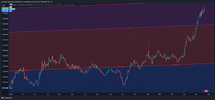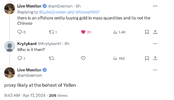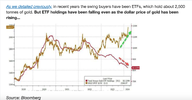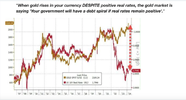Garpal Gumnut
Ross Island Hotel
- Joined
- 2 January 2006
- Posts
- 13,771
- Reactions
- 10,530

Who is the ‘massive player with deep pockets’ behind gold’s surge?
A powerful force is stalking the world’s gold market and it is operating in the shadows. Whoever it is – or they are – seems insensitive to cost.
Ambrose Evans-Pritchard
AFR Apr 17, 2024 – 8.53am
A powerful force is stalking the world’s gold market. It is operating in the shadows.
None of the normal footprints are visible on the London bullion market or the Chicago Mercantile. Retail gold bugs have not been buyers: ETF gold funds have been shrinking since December. The crowd is piling into the Bitcoin scam instead.
Yet gold has smashed through a four-year barrier around $US2000 an ounce, rising in parabolic fashion since mid-February, and hitting an all-time high of $US2431 on April 11. Is somebody preparing for an escalation of the shadow Third World War?
“It is not a Western institution behind this. It is a massive player with very deep pockets. I have never seen this kind of buying before,” said Ross Norman, a veteran gold trader and now chief executive of Metals Daily.
Gold has been ratcheting up fresh records against the headwinds of a strong dollar, a 70-point jump in 10-year US Treasury yields, and hawkish talk from the Federal Reserve. This mix would normally spell trouble for gold.
Whoever it is – or they are – seems insensitive to cost. Central banks do not behave like this.
“They buy on the London benchmark, and they don’t chase the price,” says Norman.
This rally is happening off books in the OTC market.
Yes, China’s central bank has been adding to its declared gold reserves for 17 consecutive months, part of the gradual portfolio shift away from US Treasuries and European bonds by the Global South.
Dollar weaponisation since the war in Ukraine has unnerved every country aligned with the authoritarian axis of China and Russia.
None can feel safe parking money in Western securities after Russia’s foreign reserves were frozen. Yet, the scale is modest. The World Gold Council said central banks bought a net 18 tonnes in February: 12 in China, six in Kazakhstan and India, four in Turkey, partly offset by Russian sales. This hardly moves the needle.
The Chinese people certainly have been buying gold, creating traffic jams at the Shuibei jewellery hub. Precious metal is the only refuge from the property crash and the slump on the Shanghai bourse. Tightening capital controls make it hard to smuggle serious sums abroad.
But this alone cannot account for the price surge, either. Norman says the gold flow to Asia has been within normal bounds.
Solving the mystery
So let me take two stabs at this mystery – one geopolitical and one financial.
It has been clear for three years that Russia, China and Iran are operating in collusion, each feeding opportunistically on each other. All three have fostered belligerent hyper-nationalism as a means of regime survival, and all aim to press their advantage against a fatally complacent West before the window of opportunity closes. This menace on three fronts has reached a dangerous juncture. None of the major democracies have put their economies on a war-time footing despite the obvious threat.
The West has dropped the ball on Ukraine – or worse, it is preventing Ukraine from hitting Russian oil facilities – and has therefore left the door wide open for a knock-out blow by the Kremlin this northern summer. Iran has been emboldened by Russian President Vladimir Putin’s military comeback. It is also flush with money.
US President Joe Biden is so worried about rising petrol prices that he has turned a blind eye to sanctions busting, letting Iran sell as much crude as it wants. This has enabled Tehran to advance its pawns in the Middle East, and now to risk a direct missile strike against Israel.
The third shoe has yet to drop, but China knows the West has run down its stock of military kit trying to contain these other two crises. Chinese President Xi Jinping may never have a better moment to tighten the noose on Taiwan with a naval and air blockade, gaining a stranglehold over the West’s supply of advanced semiconductors that can then be used as a bargaining chip.
How would the democracies respond to this?
A pandemic of spending
There is a strong suspicion among gold experts that China is behind the surge in buying, building up a war-fighting bullion chest through state-controlled banks and proxies.
But others, too, can see that we are living through a fundamental convulsion of the global order, and that the dollarised financial system will not be the same at the end of it.
Gold is the hedge against dystopia.
However, there is a parallel explanation. COVID-19 finally broke our spendthrift governments. The talk in hedge fund land is that some big beasts are taking bets against “fiscal dominance” across the West.
It is a collective judgment that too many countries have pushed public debt beyond 100 per cent of GDP and beyond the point of no return under prevailing economic ideologies and political regimes.
Budget deficits have broken out of historical ranges and are running at structurally untenable levels for this stage of the cycle.
Central banks will bottle it – under this scenario – to mop up issuance of treasury bonds. They will let inflation run hot to help states whittle down debts by stealth default. You might argue this is what they already did by letting rip with extreme money creation during the pandemic.
The Bank of Japan is refusing to raise rates above zero or halt bond purchases, even though core inflation is 2.8 per cent and the Rengo wage round is running at 5.2 per cent.
This is what a debt trap looks like. With a debt-to-GDP ratio above 260 per cent, Japan cannot return to sound money without risking a fiscal crisis.
Olivier Blanchard, global debt guru and former IMF chief economist, once told me how this would unfold by the mid-2020s. “One day the BoJ may get a call from the finance ministry saying, ‘Please think about us – it is a life-or-death question – and keep rates at zero for a bit longer’,” he said.
The European Central Bank is also in a debt trap. It continued to buy buckets of Club Med bonds even when inflation was over 10 per cent.
This was patently a fiscal rescue for semi-solvent states.
The ECB has backed off for now but will be forced to shield Italy again with fiscal transfers disguised as QE in the next downturn.
The Fed has largely monetised the Trump-Biden jumbo deficits.
It now faces an invidious choice: either it stays the course against inflation, at the risk of a US funding crisis, a commercial property/banking crisis, and recession, all ending in a return to QE and fiscal dominance; or it cuts rates hard and fast before inflation is under control, also ending in fiscal dominance.
Is gold sniffing this out?
Of course, the gold spike may be nothing more than wolf-pack speculation by funds orchestrating a squeeze on bullion shorts through the options market, knowing this sets off a self-fuelling feedback loop. If so, the rally will short-circuit soon enough.
My bet is that a big animal with a Chinese accent is bracing for geopolitical or monetary disorder on a traumatic scale.


Only 1 direction this goes now. LOL.
jog on
duc
I put my grandma on this two years ago. I hope so.
3. We could be on the cusp of the greatest precious metals boom in history.
Of course, i am biased
grandma-in-law much better ha ha ha ha haI put my grandma on this two years ago. I hope so.
Good evening
Meant to post this article earlier ... but got tied up ... enjoy
Commodity markets perplexed why gold keeps going up
Alex GluyasMarkets reporter AFR
Apr 19, 2024 – 11.45am
Gold’s record-breaking rally is confounding the world’s top commodity analysts and fund managers as the precious metal defies traditional price drivers to make history this year.
I
Kind regards
rcw1






Hello and welcome to Aussie Stock Forums!
To gain full access you must register. Registration is free and takes only a few seconds to complete.
Already a member? Log in here.